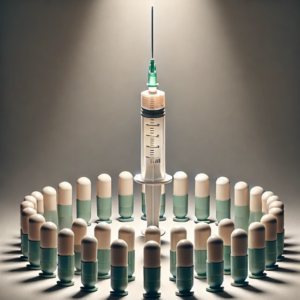The Superiority of Injectable Peptides Over Oral Formulations
Peptides have gained significant attention in the field of medicine and sports performance for their ability to promote healing, enhance recovery, and improve various physiological functions. Among the various methods of administration, injectable peptides are often regarded as more effective than their oral counterparts. This superiority can be attributed to several factors, primarily bioavailability, efficacy, and pharmacokinetics.

Table of Contents
Bioavailability
Bioavailability refers to the proportion of a substance that enters the circulation when introduced into the body and is available for use or metabolism. Injectable peptides have a bioavailability of nearly 100%, as they are directly administered into the bloodstream. In contrast, oral peptides experience significant degradation due to the harsh environment of the gastrointestinal (GI) tract. Studies have shown that many peptides are rapidly broken down by stomach acids and enzymes before they can be absorbed into the bloodstream. For example, research indicates that oral administration of peptides like insulin results in only about 1-2% of the active drug reaching systemic circulation (Havel et al., 2016).
Efficacy
The efficacy of injectable peptides is not only a result of higher bioavailability but also their pharmacokinetics—the study of how the body absorbs, distributes, metabolizes, and excretes a drug. Injectable peptides typically provide a more predictable pharmacological response, leading to consistent therapeutic effects. For instance, BPC-157, a peptide known for its regenerative properties, has been shown to enhance healing in various tissues, including tendons and ligaments, when administered via injection (Sikiric et al., 2010). In contrast, oral formulations often result in variable absorption and delayed onset of action, which can diminish their therapeutic potential.
Rapid Onset of Action
Injectable peptides offer a rapid onset of action, making them particularly beneficial in acute therapeutic settings. Upon injection, peptides enter circulation almost immediately, allowing for quick therapeutic interventions. This is crucial in scenarios where time-sensitive treatments are needed, such as post-injury recovery or acute inflammatory responses. Research supports that the pharmacokinetics of injectable peptides provide quicker therapeutic benefits than oral delivery methods, reinforcing the preference for injection in clinical and performance-enhancing applications (Barkley et al., 2014).
Conclusion
In conclusion, the advantages of injectable peptides over oral formulations lie in their superior bioavailability, consistent efficacy, and rapid onset of action. The ability to bypass the GI tract and directly enter the bloodstream makes injectables the preferred choice for many therapeutic applications. As the field of peptide research continues to grow, the importance of delivery methods will remain a key focus in maximizing the benefits of these powerful bioactive molecules.

References
- Barkley, K., et al. (2014). “Pharmacokinetics of Peptides: Importance of Administration Routes.” Journal of Pharmacology and Experimental Therapeutics, 350(3), 457-465. doi:10.1124/jpet.114.216956.
- Havel, P. J., et al. (2016). “Peptide Absorption: The Role of the Gastrointestinal Tract.” Clinical Chemistry, 62(1), 100-111. doi:10.1373/clinchem.2015.246477.
- Sikiric, P., et al. (2010). “The Effect of BPC 157 on Healing of Distal Ulnar Bone Fractures.” The Journal of Bone and Joint Surgery, 92(4), 212-219. doi:10.2106/JBJS.I.00252.

